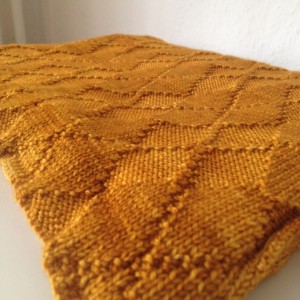10
2014Troubleshooting I: making a scarf
 It’s been quiet around Lena. What has she been doing lately? Well, she has been busy troubleshooting. As you know, troubleshooting is a frustrating and time consuming occupation, but it is part of the deal. I cannot avoid it and must go straight through.
It’s been quiet around Lena. What has she been doing lately? Well, she has been busy troubleshooting. As you know, troubleshooting is a frustrating and time consuming occupation, but it is part of the deal. I cannot avoid it and must go straight through.
People frequently ask me if I can make a scarf for them. It is easy and fast for me to make, they think, and so thought I. How wrong I was! What can be so difficult about knitting a scarf, you ask? For hand knitters it surely is the easiest thing to do. Most people have learned to knit by starting with a scarf. When you knit all stitches in the same way (NL: recht breien) you get a sturdy piece of cloth that looks the same on both sides (ENG: garter stitch). You’ll get garter stitch because you turn the work after each row.
Here we arrive at one of the main differences between hand knitting and machine knitting: a knitting machine can only make knit stitches (NL: recht op de goede en averecht op de verkeerde kant). You move the carriage but you never turn the work. As a result you’ll end up with an undefined piece of cloth that will roll up on all sides. That’s all right for making jumpers and dresses where the rolled up edges will be corrected in seams. Not much fun though, to hang an undefined piece of cloth around your neck. It will hardly give you any comfort.
I have the luxury of owning a ribber which gives me the possibility of adding the rib stitch (NL: 1 recht, 1 averecht boven elkaar) and fisherman’s rib (NL: patentsteek) to my machine knitting vocabulary. The rib stitch makes a very elastic piece of cloth, often used for trimmings.
Rib stitches are certainly suitable for a scarf and of course I tried it. The result was a scarf that did exactly what is expected of a scarf (keeping you warm, being wide and long enough to wear it as you like, being soft and having a nice colour), but it looked somewhat dull and without any signature. Moreover the maker was bored to the bone after moving the carriage endlessly from right to left and back again. Not much of a challenge. I tried numerous variations of the rib stitch but in the end it all came to nought. Just not good enough to sew my label on.
I pulled it out in order to give scarf making another chance. This time my electronic carriage would do the job. I bought it after I had learned a knitting machine was not able to combine knit and purl stitches in a pattern, like seed stitch for example (NL: rechte en averechte steken gecombineerd zoals bijvoorbeeld gerstekorrel). At that time I still had the mind set of a hand knitter and I wanted to keep all the possibilities a hand knitter has. The carriage is nicknamed THE SNAIL for it knits terribly slowly, but hey, it can do knit and purl stitches so I’m not complaining!
My goal was to make a reversible scarf, with a nice drape and no curling edges. For my little snail I adapted the classical Argyle diamonds to a pattern in knit and purl stitches. It took the snail more than two whole working days to knit the scarf. It not only knits very s l o w l y , it also knits very LOUDLY. I have never before met a snail that made such a hell of a noise. My studio was instantly transformed into a textile factory. I needed earplugs and I was concerned about what the neighbours might think of my new hobby.
After 2 x 9 hours of knitting the snail appeared to have become tired. It was mute and it stood still and it wasn’t going to do anything anymore. It broke down after knitting just one scarf! Probably it had grown weary of its own pandemonium. I praised it for not having stopped too early. The scarf had reached a proper length by then.
The result of my troubleshooting experience was fine enough to earn my label. Here you can see how it looks. I am happy to announce that I will not be able to reproduce it ;-) It is not for sale either. This one of a kind scarf has already found its loving owner!
By the way, my mind set has totally changed. By now I’m drowning in an ocean of possibilities the knitting machine offers me.
For the Dutch readers:
Knit stitch = recht
Purl stitch = averecht
Stockinette = tricot (v-tjes)
Purl side = ribbelkant
Garter stitch = alle steken recht = ribbels aan twee kanten
Rib stitch = boordsteek
Fisherman’s rib = patentsteek
Seed stitch = gerstekorrel